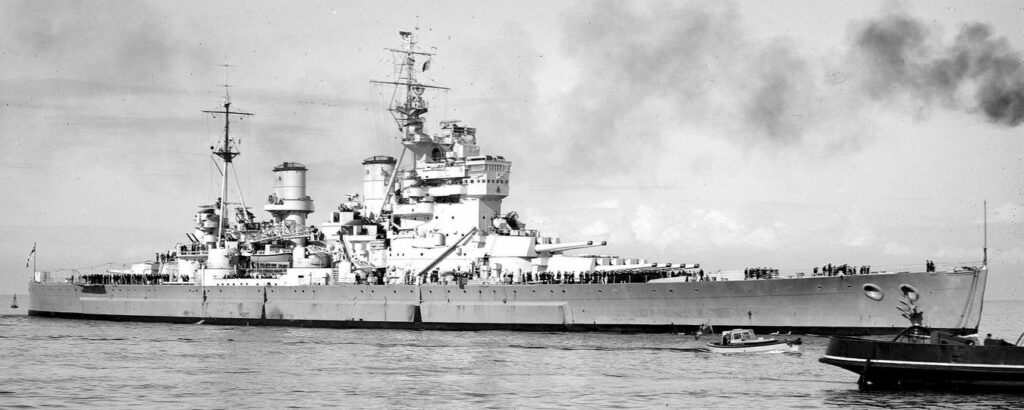HMS King George V
2024-02-21

She was laid down at Vickers-Armstrong 1 Jan 1937 just short of a year after the Kings death, and commissioned 1 Oct 1940.
Following a successful WARSHIP WEEK National Savings campaign in November 1941 she was adopted by the city of Birmingham.
She was armed with 10 × BL 14-inch Mk VII guns, 16 × QF 5.25-inch Mk I guns, and 64 × 2 pounder "pom-pom".
She displaced 42,200 tons at full load, though this was a wartime increase over the design displacement. She had a top speed of 28 knots
On commissioning she joined the Home Fleet at Scapa Flow. Her first mission was Operation Parcel the transport of Lord Halifax to the USA to take up his appointment as British Ambassador. On her return journey she embarked a US army and naval delegation of Cypher specialists and a copy of a Japanese Cypher machine (PURPLE) for Bletchley Park, as well as providing cover of convoy BHX 104. This was an important convoy consisting of 36 merchant ships of which 25 were tankers that had sailed from Bermuda.
Back at Scapa she embarked two Walrus amphibians equipped with ASV 11N radar. These were the first naval front line aircraft to be fitted with radar.
She then provided distant cover to Operation Claymore, the Royal marine attack on the Lofoten Islands. The objectives were the destruction of fish oil factories that produced glycerine the Germans used in the manufacture of explosives, and a morale boost for the home front. There was also a top secret mission to be carried out by the RN, called a 'pinch' by Bletchley Park; this was to attempt to seize an Enigma machine.
The commandoes were landed at 04:45 March 4, at 1300 hours the Commandoes re-embarked. The raiding force had destroyed 11 factories, 800,000 gallons of oil and five ships had been sunk including fish factory ship SS HAMBURG 5470grt.
A party from HMS Somali boarded the German trawler Krebs and seized Enigma paraphernalia.
The Force returned with 314 volunteers (including 8 women) for the Norwegian forces, 60 Quislings, 225 German prisoners and the English manager of Messrs Allen & Hanbury, chemists, who had been caught there in the war, all for the cost of one accidental self-inflicted wound to an officer's thigh.
May 1941 she was flagship of Admiral Tovey, commander of the Home Fleet, when the Bismarck sortied into the Atlantic. On 27 May in company with HMS Rodney she engaged Bismarck. She opened fire at 08:48 at a range of 25,500 yards, she ceased fire at 10:21, and Bismarck sank at 10:35. During the engagement that sank Bismarck she fired 339 x 14 inch and 700 x 5.25 inch. As she left the scene of Bismarck’s sinking the following signal was received at 11:37
“'We cannot visualise the situation from your signals, BISMARCK must be sunk at all costs and if to do this it is necessary for KING GEORGE V to remain on the scene, then she must do so, even if it subsequently means towing KING GEORGE V'.”
This extraordinary signal had been sent at the behest of Churchill. Tovey considered it the stupidest and most ill-considered signal ever made.
Oct 1941 she covered a raid against German shipping in Glom Fjord, Norway.
Next up she covered arctic convoys and on 1 May 1942 she was involved in a collision, with the tribal class destroyer HMS Punjabi, which had taken evasive action to avoid a mine, and cut across the front of KGV. The 40,000 ton battleship ploughed through the destroyer, cutting her in half. Punjabi’s stern would sink rapidly and would explode when her ready use depth charges reached their depth setting, 49 of her crew all stationed in the stern of the ship were lost. The explosion would also damage the USS Washington which was passing over Punjabi when the depth charges went off.
KGV would be under repair for 2 months her bow being badly damaged. She returned to the Home Fleet in July but would not sortie again until December, covering convoy JW51A.
12 August 1942 she hosted His Excellency the Turkish Ambassador.
7 Oct 1942 King Peter of Yugoslavia visited the ship followed by the Prime Minister Winston Churchill on Oct 9
18 March 1943 KGV hosted King George VI
May 1943 KGV transferred to the Med with her sister ship Duke of York taking her place as flagship of the Home Fleet. She would cover the invasions Sicily Operation Husky and Italy Operation Avalanche.
She then escorted part of the Italian fleet including the Battleships Caio Duilio, Andrea Doria, to Malta following the armistice, before covering Operation Slapstick, which were landings in Taranto, Italy. She then escorted the whole Italian fleet with 5 Battleships Vittoro Veneto, Italia, Caio Duilio, Andrea Doria and Giulio Cesare, from Malta to Alexandria, before returning to bombard German positions around Salerno. Sometime during this period her AA suite was increased with the addition of 20 x 20 mm Oerlikon guns.
She returned to the UK for an overhaul March to June 1944 which was to prepare her for operations in the Far East, she therefore had her AA suite upgraded, with the removal of one 4-barrelled 2 pdr pom-pom, 12 × 20 mm Oerlikon cannon, Type 273 radar and HF/DF, and the addition of three 8-barrelled 2 pdr pom-poms, six 2-barrelled 20 mm and two 4-barrelled 40 mm Bofors guns. Her radar suite was upgraded, her aircraft and catapult equipment, were replaced with new superstructure upon which the ship's boats were relocated, and improvements to her accommodation and ventilation.
On route to Trincomalee she briefly assisted with operations in the Aegean, before arriving in Ceylon 15 Dec 1944. In company with the carriers Illustrious, Indomitable, Indefatigable and Victorious, four cruisers and ten destroyers, she departed Trincomalee 16 Jan 1945 and headed for Sydney. On route she bombarded Japanese positions and oil refineries on Sumatra, and experienced her first air attacks by the Japanese. The task force also took time to practice replenishment at sea.
Now in company with her sister HMS Howe Task Force 57 The British Pacific Fleet, joined US forces in the Pacific. KGV was involved in operations against the Sakishimo-Gunto airfields bombarding these twice in late march and early May. She then attacked Japanese facilities on the Ryukyu Islands.
July 1945 she joined US Battleships in a bombardment of industrial installations at Hitachi. KGV fired 267 rounds during the bombardment, in company still with the US Battleships she shelled industrial facilities around Hamamatsu in southern Honshu. She then covered the four RN Carriers off Okinawa.
KGV’s last offensive actions were 29/30 July when she returned to Hamamatsu. With the dropping of the atom bombs and Japanese surrender, she made her way to Tokyo bay and was present during the formal surrender ceremonies.
Jan 1946 she conveyed the Duke and Duchess of Gloucester on an official visit to Australia, returning to Portsmouth in March, and she became flagship of the Home Fleet until Dec 1946, when she became a training vessel.
June 1950, she and her surviving sister-ships went into reserve and were mothballed.
KGV was the first large warship to be preserved in this fashion. This involved sealing the armament, machinery and boilers against damp and installing dehumidifiers throughout. Dec 1955, she was downgraded to extended reserve, and in 1957 the decision was taken to scrap the four ships. The following year KGV was moved from her berth in Gareloch to the ship breaking firm of Arnott Young and Co. in Dalmuir to undergo dismantling
During WW2 she earnt the following Battle Honours
ATLANTIC 1941 - BISMARCK Action 1941 - ARCTIC 1942-43 - SICILY 1943 - OKINAWA 1945 - JAPAN 1945
Visa ditt stöd till det informationsarbete Carl genomför
Patreon
Swish

Scanna QR eller skicka till 076-118 25 68. Mottagare är Caroline Norberg.
